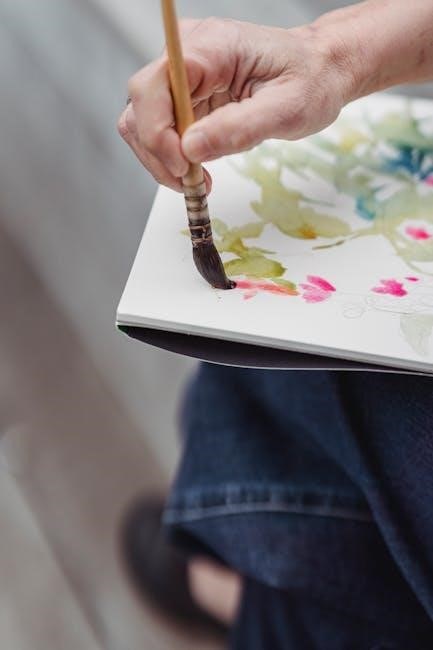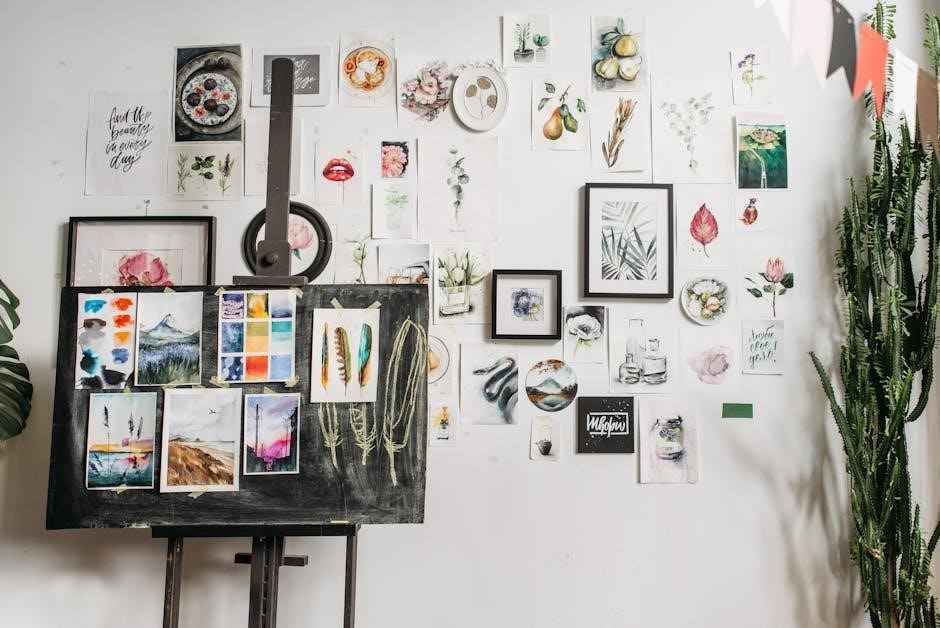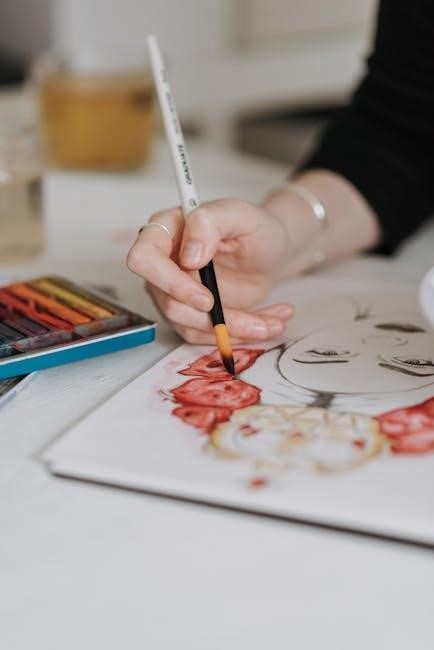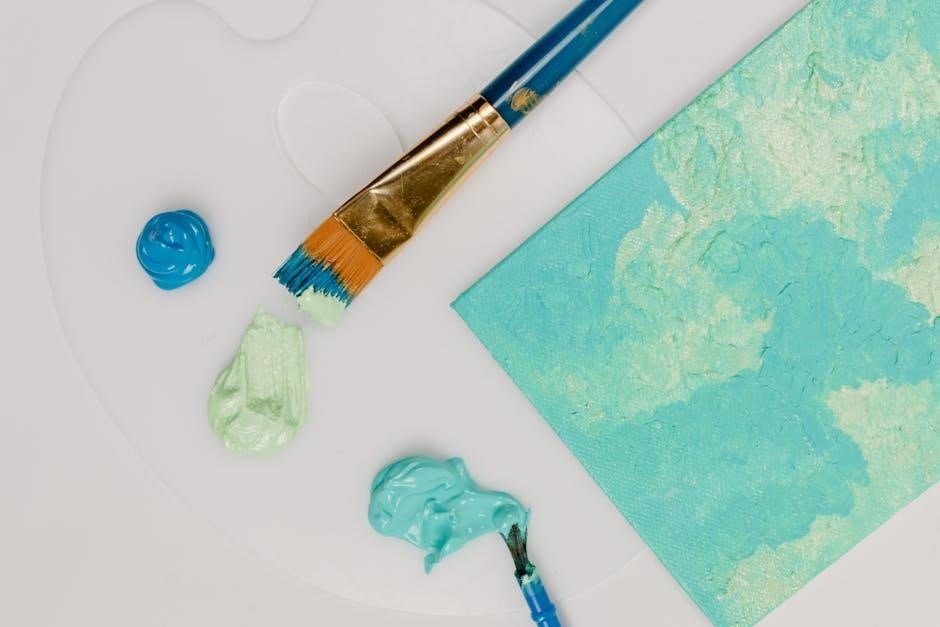
-
By:
- otis
- No comment
watercolour techniques pdf
Watercolor Painting Techniques PDF: A Comprehensive Guide
This comprehensive PDF guide delves into the captivating world of watercolor painting. From fundamental washes to advanced layering techniques, discover how to master this versatile medium. Explore essential materials, color mixing, and texture creation. Exercises and tutorials will elevate your skills, whether you’re a beginner or experienced artist.
Watercolor painting, a captivating art form, invites artists to explore its fluid and adaptable nature. This unique medium offers endless creative possibilities, lending itself to unexpected results that reflect the individual style of the artist. From picturesque landscapes to expressive character illustrations, watercolor can capture it all. It is easy to set up, but hard to master, it can produce amazing results that none other medium can achieve.
Watercolor’s versatility stems from its transparency, allowing light to interact with the paper beneath, creating luminous effects. Mastering watercolor involves understanding its nuances, from controlling pigment and water ratios to employing various techniques like wet-on-wet and wet-on-dry. Watercolor painting is a tricky medium that requires patience and practice.
The beauty of watercolor lies in its ability to blend and flow, creating soft transitions and atmospheric effects. It’s a medium that encourages experimentation and embraces happy accidents. With the right guidance and a willingness to explore, anyone can unlock the magic of watercolor painting. It is a fluid and expressive medium.
Essential Watercolor Materials
Embarking on your watercolor journey requires gathering the right tools. Start with quality watercolor paints, available in tubes or pans, each offering unique characteristics. Tube paints provide richer colors and are ideal for mixing, while pans are convenient for portability and quick washes. Investing in artist-grade paints ensures vibrant, lightfast colors that won’t fade over time. Choosing the right watercolor painting materials is essential for achieving desired results.
Next, select watercolor paper specifically designed to withstand water without buckling. Cold-press paper offers a textured surface, ideal for loose washes and granulation effects, while hot-press paper provides a smooth surface for detailed work. Consider paper weight, with heavier weights resisting warping better. A range of brushes, from small to large, will allow you to work at different scales and create various strokes.
Other essential materials include a palette for mixing colors, clean water containers, masking fluid for preserving white areas, and absorbent paper towels for controlling moisture. With these essential materials in hand, you’ll be well-equipped to explore the world of watercolor painting. Don’t forget a pencil and eraser for sketching.
Basic Watercolor Techniques: Wet-on-Dry

The wet-on-dry technique is a fundamental watercolor approach that offers precision and control. It involves applying wet paint onto dry paper, resulting in sharp, well-defined edges. Begin by ensuring your paper is completely dry. Load your brush with moistened paint, maintaining a consistent water-to-pigment ratio for even application. Use this method to capture shapes and details with precision.
The wet-on-dry technique is excellent for creating intricate details, defined shapes, and controlled washes. It allows for building up layers of color with distinct boundaries. Start with dry paper and apply paint with a loaded brush, achieving sharp lines and distinct shapes. Experiment with varying brushstrokes and color intensities to explore the versatility of this technique. This technique is perfect for adding details and achieving crisp edges in your watercolor paintings. The wet-on-dry technique is a cornerstone for beginners learning to control the medium.
Practice creating simple shapes and lines using the wet-on-dry technique. This technique is ideal for adding details and achieving crisp edges in your watercolor paintings. It’s perfect for beginners who are learning to control the medium.
Basic Watercolor Techniques: Wet-on-Wet
The wet-on-wet technique is a cornerstone of watercolor painting, celebrated for its ability to create soft, dreamy effects. This method involves applying wet paint onto wet paper, allowing colors to blend and bleed seamlessly. Begin by wetting your watercolor paper evenly with clean water. Ensure the paper is damp but not overly saturated; excess water can lead to uncontrolled blooms. Load your brush with diluted watercolor paint and gently touch it to the wet surface. Watch as the colors flow and mingle, creating soft gradations and ethereal textures.
The wet-on-wet technique is ideal for painting skies, clouds, and other atmospheric effects. Embrace the unpredictable nature of this technique and allow the colors to guide you. Experiment with different color combinations and water ratios to achieve a variety of effects. Practice controlling the flow of water and paint to create subtle gradations and atmospheric perspective. This technique is especially useful for creating backgrounds and underwashes that add depth and dimension to your paintings. The wet-on-wet technique allows for expressive and spontaneous mark-making.
Experiment with gradients and color blends using the wet-on-wet technique. This technique is perfect for capturing the fluidity and movement of water.
Creating Watercolor Washes: Step-by-Step
Creating smooth, even watercolor washes is a fundamental skill for any watercolor artist. A wash is a uniform layer of diluted paint applied to paper, used for backgrounds, skies, or establishing base tones. Here’s a step-by-step guide:
- Prepare Your Materials: Gather watercolor paper, a large, flat brush, watercolor paints, and two containers of clean water. One container is for rinsing your brush, and the other is for diluting your paint.
- Mix Your Paint: In a palette, mix your chosen watercolor paint with ample water. The consistency should be similar to tea, not too thick or too thin.
- Wet Your Paper (Optional): For a softer wash, lightly wet your paper with clean water using a large brush or sponge. This step is optional but helps the paint flow more evenly.
- Apply the Wash: Load your brush with the diluted paint. Starting at the top of your paper, apply a horizontal stroke across the entire width.
- Maintain a Wet Edge: Tilt your paper slightly downward and apply the next stroke just below the first, ensuring it touches the wet edge. This prevents hard lines from forming.
- Continue Downward: Repeat the process, overlapping each stroke slightly to maintain a seamless wash. Work quickly to keep the paper wet.
- Remove Excess Water: If you notice puddles forming, use a clean, dry brush to absorb the excess water;
- Let it Dry: Allow the wash to dry completely without disturbance. Avoid using a hairdryer, as it can cause uneven drying.
Practice creates perfect washes!
Color Mixing Techniques for Watercolor
Mastering color mixing is crucial for watercolor painting. It allows you to create a wider range of hues, tones, and shades, enriching your artwork. Here are essential techniques:
- Understand Your Palette: Start with a limited palette of primary colors (red, yellow, blue) and white. Learn their properties and how they interact.
- Color Theory Basics: Familiarize yourself with the color wheel. Understand complementary colors (opposite each other) and analogous colors (next to each other).
- Mix on a Palette: Use a palette with wells or a ceramic plate. Avoid mixing colors directly on your paper.
- Start with Light Colors: When mixing, begin with the lighter color and gradually add the darker color to achieve the desired shade.
- Mix Small Amounts: Watercolor paints are highly pigmented. Mix small amounts at a time to avoid wasting paint.
- Use Clean Water: Always use clean water to mix your colors. Dirty water can muddy the hues.
- Test Your Mix: Before applying the mixed color to your painting, test it on a scrap piece of watercolor paper to ensure it matches your vision.
- Create Gradients: Mix a base color, then gradually add more water to create lighter shades for smooth transitions.
Experiment with different color combinations to create your unique palette!
Layering Watercolor for Depth and Dimension
Layering, also known as glazing, is a fundamental watercolor technique for achieving depth and dimension in your paintings. It involves applying thin, transparent washes of color over previous layers, allowing the underlying colors to subtly influence the final result. This technique builds up richness, complexity, and a sense of realism.

Key Principles:
- Work Light to Dark: Generally, begin with lighter washes and gradually build up to darker values. This allows you to correct mistakes more easily.
- Allow Each Layer to Dry Completely: Before applying a new layer, ensure the previous layer is completely dry. Wet-on-wet layering can lead to muddy colors.
- Use Transparent Colors: Transparent watercolors allow light to pass through, creating luminous effects when layered. Opaque colors can block light and create a dull appearance.
- Vary Color Temperature: Alternate between warm and cool colors in your layers to create visual interest and depth.
- Consider Color Relationships: Think about how the colors in each layer will interact with the underlying colors.
- Use a Light Touch: Apply each layer with a gentle touch to avoid disturbing the previous layer.
- Preserve Whites: Plan your layers carefully to preserve the white areas of your paper, as they are difficult to recover once painted over.
Achieving Textures in Watercolor
Watercolor, despite its fluid nature, offers a surprising range of possibilities for creating textures. These textures can add visual interest, realism, and a unique artistic flair to your paintings. From mimicking the roughness of bark to the smoothness of glass, various techniques can be employed to achieve diverse textural effects.
Salt Technique: Sprinkle salt onto a wet wash. As the wash dries, the salt absorbs the pigment, creating a speckled texture. The size of the salt crystals affects the size of the speckles.
Dry Brush: Use a brush with minimal water and paint. Drag the brush across the paper, allowing the bristles to skip and create a broken, textured line. This is excellent for depicting rough surfaces like wood or stone.
Lifting: After a wash has partially dried, use a clean, damp brush or a paper towel to lift pigment from the paper. This can create soft, cloud-like textures or highlight areas.
Splattering: Load your brush with paint and tap it against your finger or another brush to create splatters of color. This is great for adding a sense of movement or randomness.
Masking Fluid: Apply masking fluid to areas you want to protect from paint. Once the paint is dry, remove the masking fluid to reveal the untouched paper, creating sharp, defined textures.
Plastic Wrap: Lay crumpled plastic wrap onto a wet wash. As the wash dries, the plastic wrap creates interesting patterns and textures.
Watercolor Techniques for Beginners: Exercises

Embarking on your watercolor journey can be both exciting and a little daunting. To build confidence and develop essential skills, engaging in targeted exercises is key. These exercises focus on mastering fundamental techniques, providing a solid foundation for more complex paintings.
Wash Practice: Create a series of graded washes, transitioning smoothly from light to dark. Focus on achieving even coverage and consistent color distribution. Experiment with different brush sizes and paper angles.
Color Mixing Charts: Create charts that explore color relationships. Mix primary colors to create secondary and tertiary colors. Observe how different proportions affect the resulting hues. Document your mixtures for future reference.
Wet-on-Wet Exploration: Practice painting simple shapes, like circles and squares, using the wet-on-wet technique. Observe how the colors blend and bleed together. Experiment with different water-to-paint ratios.
Wet-on-Dry Precision: Paint the same shapes using the wet-on-dry technique. Focus on achieving crisp, clean edges. Control the amount of water on your brush to prevent bleeding.
Texture Creation Sampler: Create a sampler of different texture techniques, such as salt, dry brush, and lifting. Experiment with various materials and tools to achieve unique effects.
Simple Still Life: Set up a simple still life with a few objects, like fruits or vegetables. Practice painting these objects, focusing on capturing their form, color, and texture using the techniques you’ve learned.
Free Watercolor Tutorials and Resources
The world of watercolor painting is vast and filled with inspiration. Fortunately, a wealth of free resources are available online to help you learn and grow as an artist. These tutorials and resources can provide valuable guidance, tips, and techniques to enhance your skills.
Online Video Platforms: Platforms like YouTube and Vimeo host countless watercolor tutorials created by experienced artists. Search for specific techniques, such as washes, layering, or color mixing. Many artists also share time-lapse videos of their painting process.
Artist Blogs and Websites: Many watercolor artists maintain blogs or websites where they share tips, tutorials, and demonstrations. Look for artists whose style resonates with you and explore their content.
Online Art Communities: Join online art communities and forums where you can connect with other watercolor enthusiasts. Share your work, ask questions, and receive feedback.
Free PDF Guides: Some artists and art supply companies offer free PDF guides on watercolor techniques. These guides often cover essential concepts, materials, and exercises.
Social Media: Follow watercolor artists on social media platforms like Instagram and Pinterest. These platforms can provide a steady stream of inspiration and expose you to new techniques.
Local Libraries: Don’t overlook the resources available at your local library. Many libraries offer books and DVDs on watercolor painting.
Troubleshooting Common Watercolor Problems
Watercolor painting, while beautiful, can present challenges. Understanding and addressing common issues is crucial for improvement. Here’s a guide to troubleshooting frequent problems:

Problem: Muddy Colors
Cause: Overmixing colors, using too much water, or layering colors improperly.
Solution: Limit color mixing, use clean water, and layer transparent colors carefully. Avoid overworking the paint.
Problem: Uneven Washes
Cause: Inconsistent water-to-paint ratio, uneven paper surface, or drying too quickly.
Solution: Maintain a consistent ratio, use quality watercolor paper, and work in a humid environment or add a retarder.
Problem: Backruns (Cauliflowers)
Cause: Wet paint flowing into a drier area.
Solution: Control water flow, allow areas to dry slightly before adding more paint, or use a drier brush to absorb excess water.
Problem: Lifting Color
Cause: Overworking the paint or using a soft brush.
Solution: Avoid excessive scrubbing, use a stiffer brush for lifting, and work quickly.
Problem: Paper Buckling
Cause: Using lightweight paper or applying too much water.
Solution: Use heavyweight watercolor paper (140 lb or higher) or stretch the paper before painting.
Problem: Colors Not Blending
Cause: Using incompatible pigments or allowing paint to dry too quickly.
Solution: Choose colors that blend well, work in a humid environment, or use a blending medium.